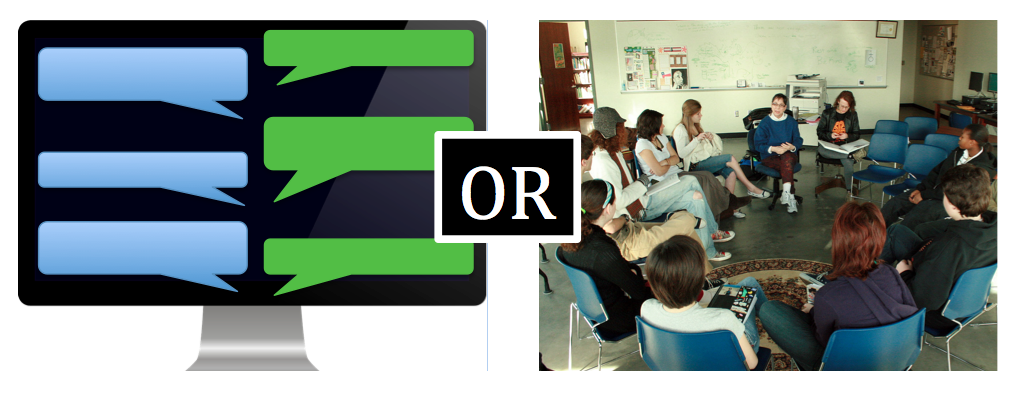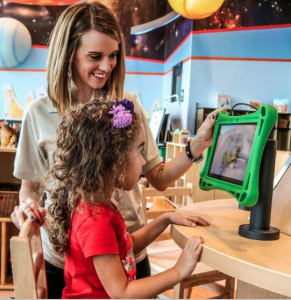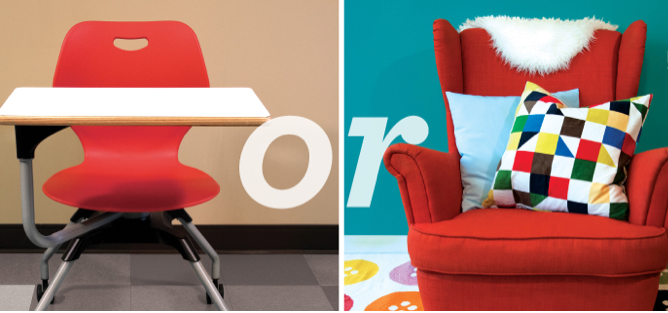You’ve heard the phrase “a picture is worth a thousand words,” right? I believe this is true and especially important when it comes to imagery that represents schools today. School images influence public perception about what “good” education looks like and how to determine if a school is a “good” school. Therefore, I think educators need to speak out when images ring false—promoting dialogue that paints accurate pictures of quality education.
The school choice movement has created a battleground for student enrollment in Arizona as organizations struggle to keep their doors open, get their doors open, or put others out of business. Competition threatens to destroy those who don’t fight because student enrollment is directly tied to school funding. As schools compete in this enrollment showdown, I’ve seen some troubling ads in the last year. I’d like to discuss two recent educational ads and offer a counter dialogue to the myths they perpetuate. I don’t intend to imply that either of these organizations (which I will not identify) are bad educational institutions. I simply intend to point out how their ads mislead the public about what quality education should be.
I saw this first ad for an online high school on a billboard about a year ago. It compares a rigid looking desk to a soft looking chair and proposes a simple question about which is more preferable.
Since this ad promotes an online high school, I assume the advertisers intend to imply that the comfy chair is the right choice. In my opinion, the comfy chair would only be a good place for high school kids to rest their backsides…if the chair were located in a real life classroom with real peers, real teachers, and authentic, engaging curriculum. This ad misleads people into thinking that learning is about where kids are sitting. I’d like to disagree by offering some images that I created to represent other possible comparisons between online high school and a brick-and-mortar school environment:


 Online high school might be the right decision for some students, but I don’t think these schools should create ads that make it look easy or comfortable. High school is hard work, and families need to see the big picture about the differences in online education when they consider such an important decision.
Online high school might be the right decision for some students, but I don’t think these schools should create ads that make it look easy or comfortable. High school is hard work, and families need to see the big picture about the differences in online education when they consider such an important decision.
I saw the second ad about a week ago on the back of two different mailers sent to my home. It was a preschool ad that mentioned STEAM and claimed to promote kindergarten readiness. There was only one image, printed in the center of the ad:

As a preschool teacher, this image of a preschool child staring at a tablet with a teacher idly watching made me groan out loud. We just can’t be using images like this to represent quality preschool education. I think preschool should look a lot more like this:
Young learners benefit from being together engaged in authentic, hands on learning. Seeing pictures of young kids staring at computer screens is disturbing. Could there possibly be market research that families find this ad desirable? Even worse, could some families dismiss the importance of enrolling in preschool when they see this ad and think, “My child already uses his tablet all the time at home?”
As educators, we can’t let misleading images speak for us. Instead, I think we should be really brave and open our practices to the families in our community. We can invite families to visit our classrooms, we can share detailed information about our quality environment, and when it’s appropriate we can share pictures or videos of students engaged in authentic learning experiences. The images we use in education DO matter. This is an enrollment showdown, and we must stand up for the things we believe in so that quality programs make it through the battle.
Image credits:
https://c2.staticflickr.com/4/3042/3058182308_c0d72d4c55_b.jpg
https://upload.wikimedia.org/wikipedia/commons/thumb/d/d9/Preschool_at_SM%26NC.jpg/640px-Preschool_at_SM%26NC.jpg
https://upload.wikimedia.org/wikipedia/commons/0/0e/Show_and_tell.jpg
https://cdn.pixabay.com/photo/2015/11/26/13/05/chemical-laboratory-1063849_960_720.png
https://upload.wikimedia.org/wikipedia/commons/e/ed/ScienceOlympiad.jpg
https://upload.wikimedia.org/wikipedia/commons/thumb/5/5d/Creative_writing_class-fine_arts_center_(402690951).jpg/1280px-Creative_writing_class-fine_arts_center_(402690951).jpg
https://static.pexels.com/photos/451/red-school-blur-factory.jpg
https://farm4.static.flickr.com/3707/13584535514_c2bb726231.jpg
https://c1.staticflickr.com/1/32/64368770_7bce91daf6_b.jpg












Comments 12
This is the kind of nuanced analysis that we need to see more often! Thank you. People are being manipulated and don’t even know it.
Many of us realize that we need to change the narrative regarding education, but this piece makes makes me realize that we need to change the images, too.
This is a great call to action! Thank you so much for providing such a great visual depiction of what real classrooms in real schools look like. This is a great way to advocate for our schools and what students really need and really look like. I have seen these ads many times in my own community, but never took my thinking past “Blah, another one?!?!” I will definitely look at these signs again much differently. Thank you for bringing this to our consciousness.
Once again you have opened my eyes Jess!!
I love this post both for its message & its images. The comparison between a brick and mortar school and a virtual school, shook me. I agree high school is hard work, and that work is made more meaningful through experiences that happen in classrooms i.e. discussions, experiential learning, etc.
I agree with Angelia, this is an ideal call to action, what can educators do when we see this imagery? How do support understanding of education as more than a “comfy” place to sit rather the experiences learners & educators involve themselves in.
Such a great reflective piece!
Thanks for this post!
Jess, you’ve nailed a major issue here. We teachers need to stand up and say something when we see the false narrative of school choice being sold to the public. I love your choice of images. Very powerful!
Once again Jess love your blog. You make some very excellent points. Very powerful images, which really gave me pause. How often do I see these images and just brush it off or simply ignore it, but can any of us in education really afford to do so. You are so spot on about how certain types of images can send wrong or mix messages about education! Radio, television and newspaper ads, plus fliers and brochures, are just some of the tools schools are using to promote themselves, but as you said, “educators need to speak out when [these] images ring false—.” https://uploads.disquscdn.com/images/9b237a551b77d84cac901f86c3e6ae6a4a782d44a7195bd8527f765a87c3a029.jpg
It’s not surprising that advertisements have become one of most influential medium to attract students; ads for school choice definitely plays a huge role in students and parents deciding where to attend school. We should be demanding that all of our education institutions be more responsible —devoid of inducements and falsehoods. My concern is what can be done? What action can be taken when these institutions go too far? It’s scary to think about the students and parents who find themselves on the wrong side relying upon these false and misleading advertisements. The biggest weapon we have to fight against this is our voices. The power is in our voices and blogs like this one. Like Angie said, this is a call for action!!
Thank you Jess.
Yes, I totally agree. It’s hard to know how we can respond–and sometimes, it takes a lot of guts! Yesterday, I got an email from an organization telling me that they had created an infographic about the “teacher shortage” that might interest me. When I looked up the piece, it was a mix of ideas from 14 “experts about how to improve the education system. Two of their “experts” had quotes saying that we should seek alternative ways to certify teachers and that there’s no difference between teachers certified through traditional and alternative methods. I was a bit stunned because these lies were hidden amidst what would otherwise be something I’d share out. I was also disappointed to see infographics citing the US as falling behind other countries in reading, math, and science. We know that these statistics are only relevant if they are disaggregated by income–since not all countries educate ALL kids. I’m not sure how it will be received, but I decided to email back the person who sent me the article and to thank him and also share my concerns about the article his organization had produced. It felt a little bit like it could fall on deaf ears, but I thought it might be worth sharing my initial reactions in case it might change their message in the future. Anyhow, for what it’s worth–I think we have to step out on the ledge regularly and invest some time in redirecting the dialogue. Thanks for your thoughts!
Hi Jess-
Thank you for posting this piece. You make some interesting points about powerful images, which we interact with and encounter daily, however we seldom stop to pause and question what we see and hear. Thanks for giving us this opportunity.
I loved your use of imagery in this blog. You’re pictures really helped to hammer in your message. I love the example about the kids with the iPads. For the last two years, I have had the benefit of having an ipad for everyone of my students. When I tell people about it, the usual response is how awesome that is for my students. (It is awesome.) However, the ipads don’t improve my classroom. I have to give quality instruction with those ipads. If I just give the kids their ipads, it becomes a game or an activity to keep them busy. I have to do something with those ipads to actually benefit my instruction. People equate technology and money to afford technology as signs of effective classrooms. However, it is still the teacher who has the biggest impact on classroom effectiveness.
SO TRUE! It’s so great that you take the opportunities to explain to family/friends why it’s the TRAINED instructor that makes the difference…not the technology. These conversations bring value to educators in our community and understanding of what we do each day
Thanks everyone for your comments and reactions! I’m so glad that others are passionate about this topic. Let’s seek out these types of ads and misleading imagery around us and create new dialogue that accurately depicts the importance of quality education and qualified educators.
Agreed with Beth about thanking you for calling out false narratives in our profession. Double thanks for speaking with authority. I swear that most of my day as a principal-in-training is spent just saying “thank you” to people to honor them and then encouraging them… daresay giving people permission… to go forth and conquer. I love it, but wonder how we, as educators, have ended up in a place where we hesitate to speak with authority. Hmmm… this might end up being a blog topic now that I type it out… lol…stay tuned. And heart you.
What an interesting post! I have never really thought about the impact education-related marketing materials can make an impact on our perceptions of education.
I especially love your use of images in this blog post: the juxtaposition of the online school advertisement you saw and the images you created (i.e. the computer with images of a scientific lab vs. students physically in a lab) drove home your point excellently.
As another commenter said, these images can send out mixed messages about what education does (and should) look like right now. The advertisement you shared with us that shows a preschooler using an iPad alludes to what is going on in a lot of our classrooms today: the integration of technology. Although I love education technology and how it can enhance the classroom experience, I agree with you totally in that that should not be a core component of someone’s preschool year. I like the photos you shared of what that should look like in an advertisement much better
Once again, great post! I very much enjoyed reading it.